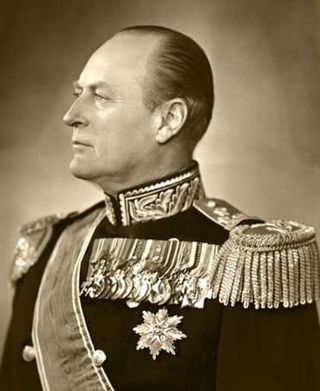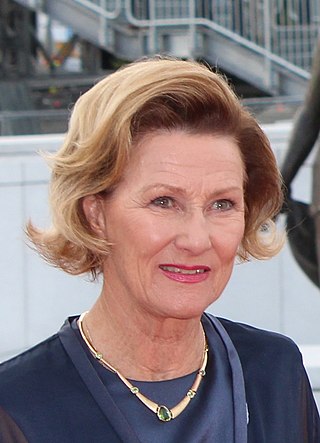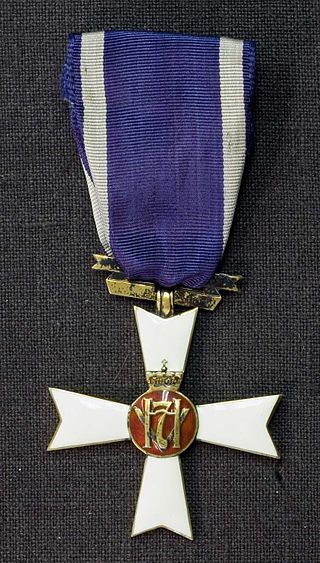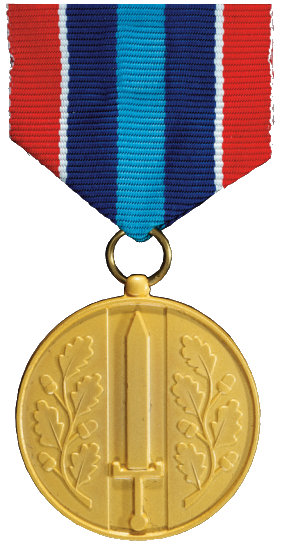
Olav V was King of Norway from 1957 until his death in 1991.

Haakon, Crown Prince of Norway is the heir apparent to the Norwegian throne. He is the only son of King Harald V and Queen Sonja.

Sonja is Queen of Norway as the wife of King Harald V.

The Royal Norwegian Order of Saint Olav is a Norwegian order of chivalry instituted by King Oscar I on 21 August 1847. It is named after King Olav II, known to posterity as St. Olav.

The War Cross with Sword is the highest ranking Norwegian gallantry decoration. It is awarded for extraordinary brave actions or extraordinary leadership during combat. A recipient deemed worthy of additional citations will receive up to an additional two swords on the medal ribbon in addition to the "standard" single sword. Additional citations are rare: Gunnar Sønsteby is the only person to have received the War Cross with three swords.

King Haakon VII's Freedom Cross was established in Norway on 18 May 1945. The medal is awarded to Norwegian or foreign military or civilian personnel for outstanding achievement in wartime. It is ranked fifth in the order of precedence in the Norwegian honours system.

The War Medal is a Norwegian war decoration for service during Second World War, and later for meritous service during war.

The King's Medal of Merit is a Norwegian award. It was instituted in 1908 to reward meritorious achievements in the fields of art, science, business, and public service. It is divided in two classes: gold and silver. The medal in gold is rewarded for extraordinary achievements of importance to the nation and society. The medal in silver may be awarded for lesser achievements. The medal is suspended from a ribbon in the colours of the Royal Standard of Norway.

Haakon VII 70th Anniversary Medal is a Norwegian military award, which was instituted by King Haakon VII of Norway on 27 October 1942. It was awarded in recognition of military personnel who served in the Norwegian armed forces in Britain on the 70th birthday of Norwegian King Haakon VII. The medal ranks 33rd in the Norwegian decoration order of precedence.
King Christian X's Liberty Medal was a commemorative decoration awarded by King Christian X for special services to Denmark during World War II.

The Defence Service Medal with Laurel Branch is a military medal of Norway. Established on 1 May 1982, the medal is awarded for outstanding or noteworthy service to the Norwegian Armed Forces. It may be awarded to Norwegians and foreigners who are civilians or military personnel.

The Medal for Defence Operations Abroad is a military medal of Norway. Established 1 April 2005, the medal currently recognises 30 days of service abroad in a designated operational area with the Norwegian Armed Forces. Participation as part of an international military staff is also creditable, so long as the service is in the area of operations.

The Medal for Defence Service Abroad is a military medal of Norway. Established 1 January 1993, the medal was originally a participant medal awarded for service during military operations that took place in the 1990s. The subsequent establishment of the Medal for Defence Operations Abroad rendered this medal obsolete. However, in 2009 the medal was reintroduced as an achievement medal. The medal was awarded for distinguished bravery and courage, beyond what is normally required during combat operations. The medal's color was changed from bronze to gold, and the ribbons of the medal would vary, depending on the area of operations. During this period of award the medal was always awarded with a rosette. Finally, in 2012 the medal was further changed to a single ribbon design for all awards. The medal may be awarded with rosette for particularly meritorious distinction.

The Civil Defence Cross of Honour is a medal which is awarded by the Directorate for Civil Protection and Emergency Planning of Norway to Norwegian civil defence personnel for helping to prevent loss of life or damage to equipment and property by act of ingenuity in perilous conditions. The medal was established 6 November 2003.

H.M. The King’s Commemorative Medal is a royal decoration of Norway. Established in 1906 by King Haakon VII, the medal is awarded to individuals for particularly meritorious service to the King. The medal is awarded in grades, gold and silver. The gold medal ranks 28th in the Norwegian order of wear just below the Antarctic Medal and above The Royal House Centenary Medal. The silver medal ranks 38th in the order of precedence below the King Olav V's 100th Anniversary Medal and above the Defence Service Medal.
The Antarctic Medal is a civil decoration of Norway. Established by King Olav V on 3 February 1960, it was awarded to the individuals associated with the Sixth Norwegian Antarctic Expedition. The medal ranks 27th in the order of precedence of Norwegian honours. The medal ranks below the Maudheim medal, but above H. M. The King's Commemorative Medal in Gold. The medal was awarded to 37 individuals who were part of or associated with Sixth Norwegian Antarctic Expedition.
The King Haakon VII 1905–1930 Jubilee Medal, also known as the King's Jubilee Medal, is a Norwegian award instituted in 1930 by Haakon VII of Norway in honor of the 25th anniversary of his accession to the throne. The medal has been conferred upon 397 people.
The King Haakon VII 1905–1955 Jubilee Medal, also known as the King's Jubilee Medal, is a Norwegian award instituted in November 1955 by Haakon VII of Norway in honor of the 50th anniversary of his accession to the throne. The medal ranks 32nd in the Norwegian decoration order of precedence.
The Royal House Centennial Medal is a Norwegian award established by Harald V of Norway to commemorate the centennial of the Norwegian royal family. The day that it was established marks the hundredth anniversary of the day that Haakon VII arrived in Norway: November 25, 1905. The medal ranks 29th in the Norwegian decoration order of precedence.

The South Pole Medal or Medal Commemorating the 1910–1911 Fram Expedition to the South Pole is a Norwegian medal established by Haakon VII of Norway on August 20, 1912 to recognize participants in Roald Amundsen's South Pole expedition. The medal was awarded to participants in the exhibition on the day it was instituted. The medal was designed by the engraver Ivar Throndsen.














